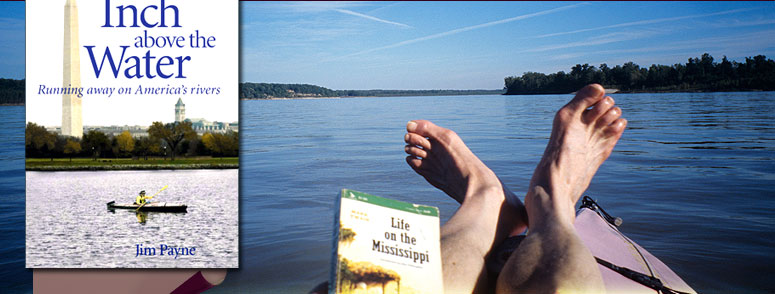Voyage on the Connecticut (page 3)
Just as I was beginning to feel comfortable about shallow rapids, the river divided around an island. I had to guess which channel would pay off better in terms of usable depth for kayaking. I picked what looked like the strongest arm of the river, but it soon grew narrow, and also rather sluggish. Something was wrong. After several hundred yards I caught a glimpse of the other branch of the river through the trees: it was three feet lower than I was! Obviously, my limb of the river was backed up, and at some point I had to drop down rapidly. I wound my way along in the narrow channel under overarching silver maples, gripping the paddle tightly, peering intently ahead.
Soon I heard the characteristic roar of turbulence ahead. The obstruction was a four-foot tree trunk that had made a dam across my channel, with some of the water running under it, and the rest cascading over the top in a waterfall. Just three feet past this barrier was a smaller tree trunk across the channel, suspended a few inches above the water. I grabbed hold of a branch to stop myself, and tried to figure out what to do. The channel was hemmed in by brush that stretched into the water on both sides: it was quite impossible to land. I clung to the limb, hoping that some bright idea would occur to me, but soon the current dragged the boat sideways overpowering my grip on the branch. The boat drifted against the obstruction sideways, completely out of control. It seemed almost certain that I would be overturned, my gear soaked, and maybe even get badly wrecked.
Instead, a miracle occurred. The current washed the boat up to the log dam, then gently carried me over the top and down to the pool below. Then the current drew the kayak along the second log until, at the far end, there was space to slide under the tree out into the open river below. All this time, I did little paddling, figuring the river knew better than I did what the boat needed to do—and it certainly did!
That evening I found an idyllic campsite 20 feet above the river at the edge of one of the cornfields so common in the fertile upper Connecticut River Valley. Most of the farmers leave a border between the corn and the river—a recent environmental innovation to reduce chemical run-off—and I found this swath of grass an excellent campsite: clean, level, and secluded. I had a great vista, with the river below and the purple mountains in the distance. After pitching my tent, I went back down to the river and turned the kayak over to inspect the bottom. I found no tears or cuts: I rendered thanks unto Klepper for making such a sturdy craft.
Back to First Page • Next Page >

